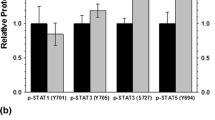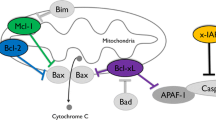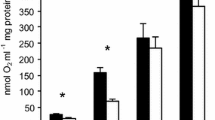Abstract
The 13-lined ground squirrel (Ictidomys tridecemlineatus) is capable of entering into extended periods of torpor during winter hibernation. The state of torpor represents a hypometabolic shift wherein the rate of oxygen consuming processes are strongly repressed in an effort to maintain cellular homeostasis as the availability of food energy becomes limited. We are interested in studying hibernation/torpor because of the robust state of tolerance to constrained oxygen delivery, oligemia, and hypothermia achieved by the tissues of hibernating mammals. The role of the serine/threonine kinase Akt (also known as PKB) has been examined in torpor in previous studies. However, this is the first study that examines the level of Akt phosphorylation in the liver during the two transition phases of the hibernation cycle: entrance into torpor, and the subsequent arousal from torpor. Our results indicate that Akt is activated in the squirrel liver by phosphorylation of two key residues (Thr308 and Ser473) during entrance into torpor and arousal from torpor. Moreover, we observed increased phosphorylation of key substrates of Akt during the two transition stages of torpor. Finally, this study reports the novel finding that PRAS40, a component of the TORC1 multi-protein complex and a potentially important modulator of metabolism, is regulated during torpor.




Similar content being viewed by others
References
Abnous K, Dieni CA, Storey KB (2008) Regulation of Akt during hibernation in Richardson’s ground squirrels. Biochim Biophys Acta 1780(2):185–193
Alexia C, Bras M, Fallot G, Vadrot N, Daniel F, Lasfer M, Tamouza H, Grover A (2006) Pleiotropic effects of PI-3′ kinase/Akt signaling in human hepatoma cell proliferation and drug-induced apoptosis. Ann N Y Acad Sci 1090:1–17
Cai D, McCarron RM, Yu EZ, Li Y, Hallenbeck J (2004) Akt phosphorylation and kinase activity are down-regulated during hibernation in the 13-lined ground squirrel. Brain Res 1014(1–2):14–21
Chong ZZ, Li F, Maiese K (2007) The pro-survival pathways of mTOR and protein kinase B target glycogen synthase kinase-3beta and nuclear factor-kappaB to foster endogenous microglial cell protection. Int J Mol Med 19(2):263–272
Drew KL, Tǿien Ǿ, Rivera PM, Smith MA, Perry G, Rice ME (2002) Role of the antioxidant ascorbate in hibernation and warming from hibernation. Comp Biochem Physiol C Toxicol Pharmacol 133(4):483–492
Duronio V (2008) The life of a cell: apoptosis regulation by the PI3K/PKB pathway. Biochem J 415(3):333–344
Eddy SF, Storey KB (2003) Differential expression of Akt, PPARgamma, and PGC-1 during hibernation in bats. Biochem Cell Biol 81(4):269–274
Eddy SF, McNally JD, Storey KB (2005) Up-regulation of a thioredoxin peroxidase-like protein, proliferation-associated gene, in hibernating bats. Arch Biochem Biophys 435(1):103–111
Fleck CC, Carey HV (2005) Modulation of apoptotic pathways in intestinal mucosa during hibernation. Am J Physiol Regul Integr Comp Physiol 289(2):586–595
Franke TF (2008) Intracellular signaling by Akt: bound to be specific. Sci Signal 1(24):pe29
Frerichs KU, Hallenbeck JM (1998) Hibernation in ground squirrels induces state and species-specific tolerance to hypoxia and aglycemia: an in vitro study in hippocampal slices. J Cereb Blood Flow Metab 18(2):168–175
Frerichs KU, Kennedy C, Sokoloff L, Hallenbeck JM (1994) Local cerebral blood flow during hibernation, a model of natural tolerance to “cerebral ischemia”. J Cereb Blood Flow Metab 14(2):193–205
Frerichs KU, Smith CB, Brenner M, DeGracia DJ, Krause GS, Marrone L, Dever TE, Hallenbeck JM (1998) Suppression of protein synthesis in brain during hibernation involves inhibition of protein initiation and elongation. Proc Natl Acad Sci USA 95(24):14511–14516
Geiser F (1988) Reduction of metabolism during hibernation and daily torpor in mammals and birds: temperature effect or physiological inhibition? J Comp Physiol B 158(1):25–37
Guertin DA, Sabatini DM (2007) Defining the role of mTOR in cancer. Cancer Cell 12(1):9–22
Helgen KM, Cole FR, Helgen LE, Wilson DE (2009) Genetic revision of in the holarctic ground squirrel genus Spermophilus. J Mammal 90:270–305
Hittel D, Storey KB (2002) The translation state of differentially expressed mRNAs in the hibernating 13-lined ground squirrel (Ictidomys tridecemlineatus). Arch Biochem Biophys 401(2):244–254
Hoehn KL, Hudachek SF, Summers SA, Florant GL (2004) Seasonal, tissue-specific regulation of Akt/protein kinase B and glycogen synthase in hibernators. Am J Physiol Regul Integr Comp Physiol 286:R498–R504
Huang J, Manning BD (2009) A complex interplay between Akt, TSC2 and the two mTOR complexes. Biochem Soc Trans 37(Pt 1):217–222
Jacinto E, Facchinetti V, Liu D, Soto N, Wei S, Jung SY, Huang Q, Qin J, Su B (2006) SIN1/MIP1 maintains rictor-mTOR complex integrity and regulates Akt phosphorylation and substrate specificity. Cell 127(1):125–137
Kaper F, Dornhoefer N, Giaccia AJ (2006) Mutations in the PI3K/PTEN/TSC2 pathway contribute to mammalian target of rapamycin activity and increased translation under hypoxic conditions. Cancer Res 66(3):1561–1569
Kops GJ, Dansen TB, Polderman PE, Sarloos I, Wertz KW, Coffey PJ, Huang TT, Bos JL, Medema RH, Bergering BM (2002) Forkhead transcription factor FOXO3a protects quiescent cells from oxidative stress. Nature 419(6904):316–321
Kovacina KS, Park GY, Bae SS, Guzzetta EW, Schaeffer E, Birnbaum MJ, Roth RA (2003) Identification of a proline-rich Akt substrate as a 14-3-3 binding partner. J Biol Chem 278(12):10189–10194
Lee M, Choi I, Park K (2002) Activation of stress signaling molecules in bat brain during arousal from hibernation. J Neurochem 82(4):867–873
Mamady H, Storey KB (2006) Up-regulation of the endoplasmic reticulum molecular chaperone GRP78 during hibernation in thirteen-lined ground squirrels. Mol Cell Biochem 292(1–2):89–98
Morin P Jr, Storey KB (2006) Evidence for a reduced transcriptional state during hibernation in ground squirrels. Cryobiology 53(3):310–318
Morin P Jr, Storey KB (2007) Antioxidant defense in hibernation: cloning and expression of peroxiredoxins from hibernating ground squirrels, Spermophilus tridecemlineatus. Arch Biochem Biophys 461(1):59–65
Morin P Jr, Ni J, McMullen DC, Storey KB (2008) Expression of Nrf2 and its downstream gene targets in hibernating 13-lined ground squirrels, Spermophilus tridecemlineatus. Mol Cell Biochem 312(1–2):121–129
Noshita N, Lewén A, Sugawara T, Chan PH (2001) Evidence of phosphorylation of Akt and neuronal survival after transient focal cerebral ischemia in mice. J Cereb Blood Flow Metab 21:1442–1450
Orr AL, Lohse LA, Drew KL, Hermes-Lima M (2009) Physiological oxidative stress after arousal from hibernation in Arctic ground squirrel. Comp Biochem Physiol A Mol Integr Physiol 153(2):213–221
Oshiro N, Takahashi R, Yoshino K, Tanimura K, Nakashima A, Egushi S, Miyamoto T, Hara K, Takehana K, Avruch J, Kikkawa U, Yonezawa K (2007) The proline-rich Akt substrate of 40 kDa (PRAS40) is a physiological substrate of mammalian target of rapamycin complex 1. J Biol Chem 282(28):20329–20339
Paradis S, Ruvkun G (1998) Caenorhabditis elegans Akt/PKB transduces insulin receptor-like signals from AGE-1 PI3 kinase to the DAF-16 transcription factor. Genes Dev 12(16):2488–2498
Rayasam GV, Tulasi VK, Soghi R, Davis JA, Ray A (2009) Glycogen Synthase Kinase 3: more than a namesake. Br J Pharmacol 156:885–898
Reiling JH, Sabitini DM (2006) Stress and mTORture signaling. Oncogene 25(48):6373–6383
Sancak Y, Thoreen CC, Peterson TR, Lindquist RA, Kang SA, Spooner E, Carr SA, Sabatini DM (2007) PRAS40 is an insulin-regulated inhibitor of the mTORC1 protein kinase. Mol Cell 25(6):903–915
Sarbassov DD, Ali SM, Sabatini DM (2005) Growing roles for the mTOR pathway. Curr Opin Cell Biol 17(6):596–603
Seol DW (2008) Up-regulation of IAPs by PI-3K: a cell survival signal-mediated anti-apoptotic mechanism. Biochem Biophys Res Commun 377(2):508–511
Shah OJ, Kimball SR, Jefferson LS (2000) Among translational effectors, p70S6k is uniquely sensitive to inhibition by glucocorticoids. Biochem J 347(Pt 2):389–397
Storey KB (2003) Mammalian hibernation transcriptional and translational controls. Adv Exp Med Biol 543:21–38
Storey KB, Storey JM (1990) Metabolic rate depression and biochemical adaptation in anaerobiosis, hibernation and estivation. Q Rev Biol 65(2):145–174
Storey KB, Storey JM (2004) Metabolic rate depression in animals: transcriptional and translational controls. Biol Rev Camb Philos Soc 79(1):207–233
Thedieck K, Polak P, Kim ML, Molle KD, Cohen A, Jeno P, Arrieumerlou C, Hall MN (2007) PRAS40 and PRR5-like protein are new mTOR interactors that regulate apoptosis. PLoS ONE 2(11):e1217
Toschi A, Lee E, Gadir N, Ohh M, Foster DA (2008) Differential dependence of hypoxia-inducible factors 1 alpha and 2 alpha on mTORC1 and mTORC2. J Biol Chem 283(50):34495–34499
Tran H, Brunet A, Grenier JM, Datta SR, Fornace AJ Jr, DiStefano PS, Chiang LW, Greenberg ME (2002) DNA repair pathway stimulated by the forkhead transcription factor FOXO3a through the Gadd45 protein. Science 296(5567):530–534
Van Breukelen F, Martin SL (2001) Translational initiation is uncoupled from elongation at 18 degrees C during mammalian hibernation. Am J Physiol Regul Integr Comp Physiol 281:R1374–R1379
Van Breukelen F, Martin SL (2002) Reversible depression of transcription during hibernation. J Comp Physiol B 172:355–361
Van Breukelen F, Sonenberg N, Martin SL (2004) Seasonal and state-dependent changes of eIF4E and 4E-BP1 during mammalian hibernation: implications for the control of translation during torpor. Am J Physiol Regul Integr Comp Physiol 287(2):R349–R353
Vander Haar E, Lee SE, Bandhakavi S, Griffin TJ, Kim DH (2007) Insulin signalling to mTOR mediated by the Akt/PKB substrate PRAS40. Nat Cell Biol 9(3):316–323
Wang LCH, Lee TF (1996) Torpor and hibernation in mammals: metabolic, physiological, and biochemical adaptations. In: Fregley MJ, Blatteis CM (eds) Handbook of physiology: environmental physiology, section 4, vol 1. Oxford University Press, New York, pp 507–532
Wang L, Harris TE, Roth RA, Laurence JC Jr (2007) PRAS40 regulates mTORC1 kinase activity by functioning as a direct inhibitor of substrate binding. J Biol Chem 282(27):20036–20044
Whiteman EL, Cho H, Birnbaum MJ (2002) Role of Akt/protein kinase B in metabolism. Trends Endocrinol Metab 13(10):444–451
Zhang F, Beharry ZM, Harris TE, Lilly MB, Smith CD, Mahajan S, Kraft AS (2009) PIM1 protein kinase regulates PRAS40 phosphorylation and mTOR activity in FDCP1 cells. Cancer Biol Ther 8(9):846–853
Acknowledgments
The authors would like to thank Jan Storey and Dr. Maria Spatz for critical review of this manuscript. This research was supported (in part) by the Intramural Research Program of the NIH, NINDS.
Author information
Authors and Affiliations
Corresponding author
Additional information
Communicated by H.V. Carey.
Rights and permissions
About this article
Cite this article
McMullen, D.C., Hallenbeck, J.M. Regulation of Akt during torpor in the hibernating ground squirrel, Ictidomys tridecemlineatus . J Comp Physiol B 180, 927–934 (2010). https://doi.org/10.1007/s00360-010-0468-8
Received:
Revised:
Accepted:
Published:
Issue Date:
DOI: https://doi.org/10.1007/s00360-010-0468-8




